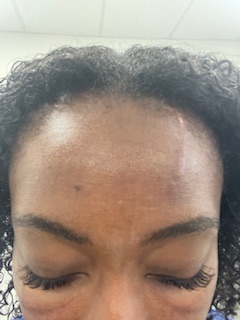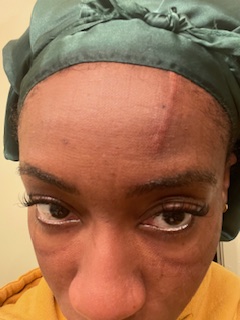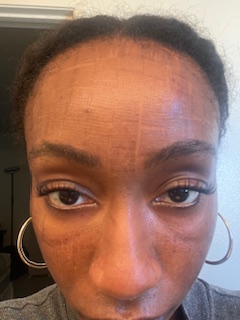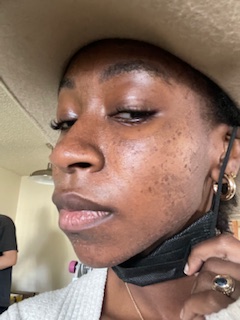
What Is The 3D Miracl Laser Treatment?
The 3DMIRACL Ultra Clear is coined the first cold fiber ablative laser and is marketed as an all encompassing treatment that not only tackles superficial and deep layers of the skin but can treat all skin tones. This is a massive positive note as there are hardly any “one size fits all” machines and so a laser with light enough settings to tackle dark skin types and stronger settings for lighter skin types is hard to come by. The reason why those with darker skin types (Asian skin, African skin, olive Mediterranean and deeper tones) must be more careful with lasers compared to those who have less pigment in their skin is because lasers involve heat and skin types with more pigment tend to also be more prone to hyperpigmentation and scarring. Lighter skin types can have hyperpigmentation too but extra melanin in the skin mixed with intense heat can cause excitability in the melanocytes and cause hyperpigmentation or hypopigmentation (loss of pigment) if settings are too strong. Especially when hormones come into play, conditions like melasma (hormonally driven patches of hyperpigmentation) can be very difficult to treat and the same treatment meant to reduce the melasma, may also make it worse. So pigment is very important when dealing with lasers, that’s why this type of laser can be seen as groundbreaking. In this article we’ll break down the 3D Miracl Ultra Clear treatment and go through the reality of healing, aftercare and results.
What are Fractional Lasers
Fractional lasers (whether ablative or not ablative) are used to create controlled injuries to the skin. Semi-fractional lasers leave other areas intact so that healing time is quickened. With other parts of your skin not injured, they can aid in healing the injured skin quicker as opposed to using a fully ablative laser which does not leave other areas of skin intact. With a full ablative laser the downtime is much more, it can be several days to weeks to fully heal.
The Ultra Clear Laser and All Its Settings
The Ultra Clear Laser has 6 different modes starting with ablative lasering of the epidermis (superficial layer) to reduce fine lines, even out skin tone and even help with melasma, all the way to surgical mode which involves actually cutting skin. The 3D Miracl is the most superficial level of the Ultra clear machine. It is described as a mid-infrared ablative cold laser. It has a wavelength of 2910 nm which targets the water in the tissue. This is important because water absorbs the light well at this wavelength, optimizing efficacy of the treatment. The laser creates precise tissue ablation in depths of the outer layer of skin while also emitting coagulation to limit bleeding. This action reduces unwanted thermal damage to surrounding areas which significantly reduces the likelihood of PIH (post- inflammatory hyperpigmentation) or other thermal induced complications that heavily strike Asian skin types and those with deeper skin tones after lasers.
Is the 3D Miracl Truly Painless?
Even though this laser is marketed as a cold ablative laser, it DOES NOT mean it’s cold (I learned this the hard way). If you’ve done laser treatments like clear and brilliant (semi-fraxel laser) or a full fractional CO2 laser, the 3D miracl setting on the Ultra Clear machine is the most superficial and most tolerable setting compared to other laser treatments. Even without numbing it can be more tolerable than the Clear and brilliant and definitely the CO2 laser WITH numbing. I did my full face with the 3D Miracl setting and I treated my scar on my forehead and a deep line by my under eye and cheek junction with the Ultra Mode which is deep rejuvenation to mid dermis. I did numb for about 20-30 mins but also had my numbing off for about 20-30 mins before actually being treated. I say this because as soon as you remove numbing cream the numbing effect starts dwindling. I also always numbed for atleast 45mins with clear and brilliant and it was still spicy.
When I was treated for the 3D Miracl, it was a piece of cake. I barely felt it in some areas. It is marketed as a treatment you could do without numbing which I believe is possible. Even though I had numbed previously, anyone who is familiar with laser treatments knows that numbing cream can only go so far in terms of reducing pain. I’d give the pain score for 3D Miracl a 2-3 out of 10 with my slightly numbed face. Beyond tolerable. When I felt it in areas where I wasn’t numbed, honestly the most pain I’d give it is a 5. You will feel it but it’s much less painful than other ablative lasers and that’s where that “cold” phrase comes in.
Now for the rest of the modes that go deeper or ablate more of your skin, they do suggest you numb for at least 45 mins, but if you have a high pain tolerance you may get away with 30 mins. The numbing I used is a mixture of benzocaine, lidocaine, and tetracaine (BLT) which is a strong combination of local anesthetics meant to block nerve signals of pain and desensitize the tissues. Might as well use the strong stuff! The deeper modes near my under eye and scar region were definitely more sensitive but again still very tolerable. They were smaller areas so if you have more acne scarring throughout your face to treat, the stinging would last longer and may be considered more painful. For me, I’d give the Ultra mode pain a 6/10.
Reality Of The Treatment vs Marketing
Now I’d like to address some misconceptions about the treatment as a lot of treatments market themselves as “painless” or minimal downtime which tend to not correlate with the actual treatment. Here’s my opinion on the marketing vs the reality of the treatment:
When we received the machine at our office it was marketed as a painless, lunchtime treatment with no downtime, great for all skin types, cold laser, no numbing needed…
- In reality, the painless, “cold” laser is used to describe the superficial mode of the 3D Miracl laser but the other modes you do need numbing of about 45 mins.
- Even with the 3D Miracl which is the most superficial level, there will be noticeable downtime depending on coverage settings. Personally with clear and brilliant and even the notoriously painful Morpheus (microneedling radiofrequency) I had minimal downtime. The initial day I may have been swollen but the following days showed minimal signs of my treatment. The 3D Miracl is the most visible downtime I’ve ever had with lasers. You can’t really hide it, it’s just tracks of scabbed stamps of dots throughout your face. For me it got worse at day 3 and continued on day 5 where it finally started peeling. Now, I have darker skin and everyone is different but I usually never have issues with healing from treatments or products on my skin. I’d say my skin is pretty resilient. This treatment downtime surprised me because of the minimal pain compared to the other treatments, and the suggestions of minimal downtime of a few days. Downtime can mean how long it takes for you to fully heal but it can also flat out mean how crazy you’ll look. It will take atleast a week to one week and a half to fully heal and I looked pretty crazy (scabs all over my face) for atleast a week. Now I didn’t test out whether makeup would hide anything as I like to just let my skin breathe and heal post an invasive treatment. When you wear makeup, you often have to wash the skin vigorously to get the makeup off, increasing the chance of scrubbing off the scabs accidentally and causing scarring, hypopigmentation or hyperpigmentation.
- It is a laser that can be used on all skin types. It’s highly customizable. However, the complexity of it does bring some risk to those with deeper skin as high settings or overlapping passes can cause adverse reactions.
- Depending on the tailored treatment you’re getting, it can take 25 mins to 30 mins to do the procedure, just depending on if you need breaks, etc. So I wouldn’t plan on it just being 15 mins as advertised especially for the first visit.
Aftercare
After the procedure you’re red, swollen and hot. The inflammation definitely builds. It’s not unbearable and the inflammation doesn’t last for more than a few hours so I’d recommend just getting through it. Over the next couple of days you may experience itching and tightness to the skin which is all part of the healing process. After the treatment, my goal is to always use the best skincare that is made for post procedure as you want to have all the safe but nourishing ingredients absorbed readily into the skin. Alastin Skin Nectar is my go-to serum after any invasive treatment. Their patented Tri-hex technology helps remove old collagen taking up space and make room for a surplus of collagen and elastin especially after a procedure. It heightens your results so it’s always a must use for me.
Skincare Used During Aftercare
- Day 1 all you really need is Alastin Skin nectar. It’s not water based so reduces chance of irritation
- Day 2 I used Skin Medica’s Power Duo Procedure 360 System after washing skin with Cetaphil wash. This includes a post procedure repair complex and a restorative ointment to seal in moisture. The repair complex is a blend of growth factors and stem cell factors that enhances the regeneration process to support scarless wound healing and bring skin to its optimal health. Now, the first ingredient is water and surprisingly it did burn when applying in the morning of Day 2 but that is to be expected with an ablative treatment. I just figured since this product was made for post procedure it would be less likely to sting. I was wrong. Most likely has to do with the ph of the serum vs my ablated skin but next time I would just wait an extra day to use this as the third day my skin was not irritated by it at all. After using the repair complex I used the Alastin Skin Nectar and then the Restorative Ointment at the end. The restorative ointment has the consistency of Vaseline. It helps to soothe the skin and support the healing process. It contains ingredients like castor oil, triglyceride and squalene for deep hydration. I leave about 2-5 mins between my skincare application for absorption.
- Day 3-5 I washed my skin with Elta MD’s foaming cleanser (My all time favorite cleanser!). It is oil free, sensitivity free and ph balanced. It’s a gentle enzymatic cleanser that washes off impurities and leaves skin feeling clean but not stripped. After this I used the same skincare routine. Something I added on Day 3 and 4 was the omnilux face mask. The red LED mask helps stimulate collagen production, quickens healing time and reduces inflammation. My skin felt refreshed afterwards.
Pricing?: about $800 per treatment
How many treatments do I need?: Most lasers or any treatment relying on you building your own collagen will take about 3-6 treatments but of course it depends on your condition, age, skin type and goals. The before and after pictures from this treatment though are amazing. Even after one there’s obvious reduction in scars, fine lines, hyperpigmentation, etc. Most people can expect to see some difference in each treatment.
What should I avoid?: Avoid tretinoin or retinols and peels prior to treatment as retinols will cause the laser to penetrate deeper, leaving room for adverse reactions to occur. Avoid for 2 weeks. Also avoid some antibiotics that tend to make you more sensitive to lasers and the sun. Avoid the sun for two weeks as a tan can also increase inflammation and the risk of an adverse reaction.
This is an effective treatment for supplementing the skin with collagen and creating an overall glow to the skin. It can also treat deep wrinkles and slightly sagging skin. This laser can be recommended to many people with various conditions.
Photos Post Treatment























You must be logged in to post a comment.